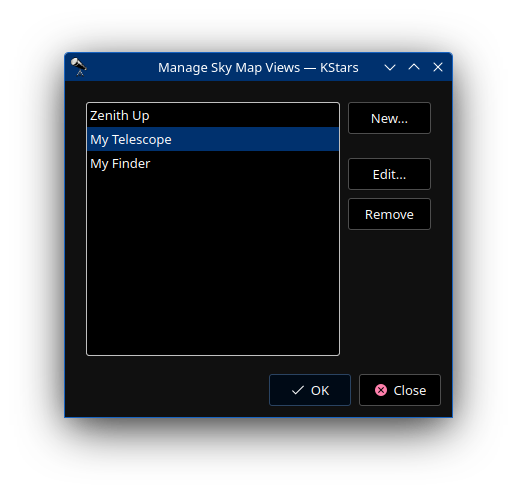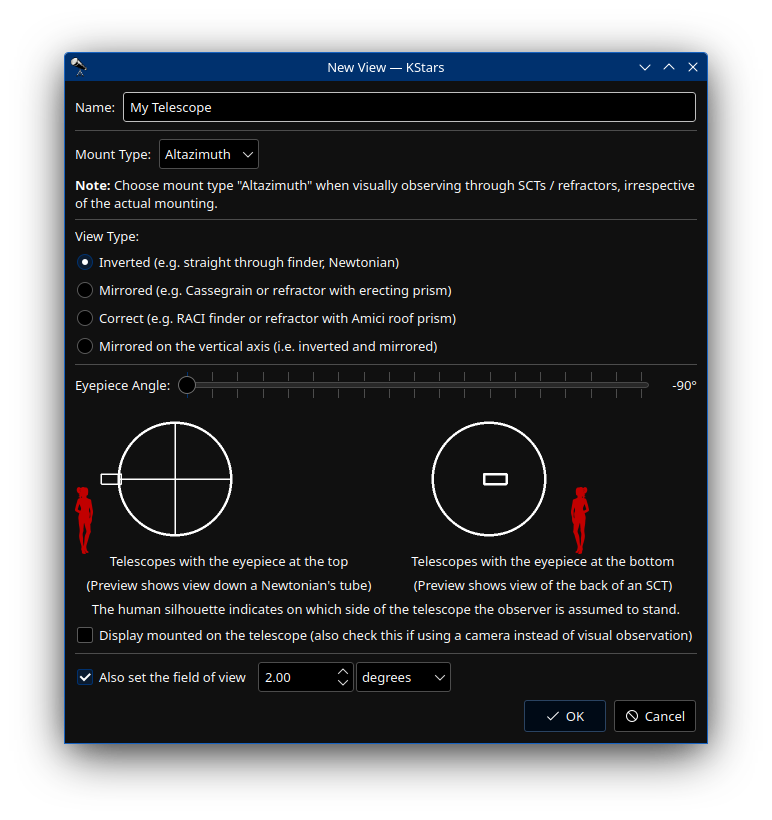You can tweak various settings to make the orientation of the sky map match the view through your optical instrument.
First, pick the coordinate system that matches your mount. For an equatorially mounted instrument, switch to the Equatorial Coordinate mode in the menu or by pressing the Space key. The option to toggle the coordinate system should read Switch to Horizontal View (Horizontal Coordinates) when the current mode is Equatorial Coordinates. For an altazimuth-mounted instrument or naked-eye viewing, switch to Horizontal Coordinates, so that the option in the menu reads Switch to Star Globe View (Equatorial Coordinates). This sets the base coordinate system used to render the sky map, and also sets the reference for the orientation of the skymap: zenith or north.
If your instrument is using an erecting prism, typically used on Schmidt-Cassegrain and refracting type telescopes, the view through the eyepiece will be mirrored horizontally. You can have the sky map match this by checking the Mirrored View option under the menu, or using the key combination Ctrl+Shift+M.
Next, to rotate the sky map freely, you can hold down the Shift key and drag the mouse on the sky map. A temporary overlay will appear showing the direction of north and zenith at the point, and displaying the angle they make with the vertical in a counterclockwise sense. The orientations of zenith and north will update as you rotate the sky map. Letting go of Shift or the mouse button will stop the rotation operation. As you pan the sky map or focus it on different objects, the rotation you set is retained as an offset from the reference direction. The reference direction is north when using Equatorial Coordinates and zenith when using Horizontal Coordinates. As a reminder, the reference direction is solid and brighter in the temporary overlay. The temporary overlay also marks the East direction, which will be clockwise from north when mirrored and counter-clockwise when not mirrored. For the two common orientations of erect and inverted, the rotation can be set / reset using the → submenu. Select North Down or Zenith Down as is applicable to set an orientation of 180 degrees.
If you are visually observing through an eyepiece of an instrument, you may need to do some more correction. For the common case of a large Dobsonian telescope (or more generally a Newtonian design mounted on an altazimuth mount), an additional systematic correction is of help. This correction applies because we stand erect while using the telescope irrespective of the angle the telescope tube is making with the ground. So as we move the telescope in altitude, an additional correction depending on the altitude of the object needs to be applied to make the sky map match the view through the eyepiece where the observer is standing erect. This correction is enabled by choosing the appropriate "Erect observer correction" option in the → submenu. The correction depends on which side the telescope's focuser is placed by the manufacturer. If when observing just above the horizon through the eyepiece, the sky is on the observer's right side (and the mirror to the left), pick the Erect observer correction, right-handed option. Similarly, if the sky is to the left of the observer, choose the Erect observer correct, left-handed option. This correction only makes sense in Horizontal Coordinate mode and is disabled when using equatorial coordinates.
We now provide some examples of how to use these settings for various instruments:
Naked-eye observing: Choose Horizontal Coordinates and a Zenith Up orientation under → .
Camera on an equatorially mounted telescope: Choose Equatorial Coordinates and adjust the orientation of the sky map so that it matches your camera. As your mount points to different regions of the sky, the orientation should be rendered correctly.
Using binoculars: Same settings as Naked-eye observing
Eyepiece of an altazimuth Schmidt-Cassegrain telescope with an erecting prism: Under the menu, choose Mirrored View, and under the sub-menu, choose Zenith Up. Finally, tweak the rotation manually to match the eyepiece view according to the angle you are using for your erecting prism.
Using a RACI finder scope on an altazimuth mounted telescope, looking straight down into it: Same settings as Naked-eye observing, except you may need to tweak the orientation manually once if you have it mounted at an angle
Using a RACI finder scope on an altazimuth mounted telescope, looking through it from the side: In addition to the aforementioned, enable Erect observer correction for the appropriate side.
Using a straight-through (inverted view) finder scope on an altazimuth mounted telescope: Choose Horizontal Coordinates and a sky-map orientation of Zenith Down in → submenu
Eyepiece of a Dobsonian telescope: Choose Horizontal Coordinates, and in the → submenu, select Zenith Down and enable the erect observer correction, picking the left/right handed option as is appropriate for your telescope. Then adjust the orientation manually once to match your telescope eyepiece view, and it should henceforth track it correctly.
It is typical in visual astronomy to use at least three different instruments: the unaided eye, a finder scope, and the main telescope. The orientations of these three will have different settings and will need frequent modification of all the aforementioned options. To make it easy to adjust these settings together, KStars provides the Views feature. This feature is accessible through the → menu and the options contained therein. The Arbitrary view is not a real view, but the option that gets selected when the sky-map orientation is modified manually through the previously described options. The rest of the views are bona fide views. New views may be added, or the existing views may be edited, removed, or re-ordered using the → → option. Choosing this brings up a window to manage the views:

To remove a view, simply select the view from the list and delete it using the button. To re-order the views, use the mouse to drag the view you wish to move and drop it at its destination in-between two other entries. To edit a view, select the view from the list and click . To create a new view, click the button. The and options bring up a view editor interface:

The Name field carries a unique name for the View. The Mount Type determines whether the reference direction used for orientation will be north or zenith. Typically, one would set this to the type of mount used for the telescope. However, when using refractors and Schmidt-Cassegrain Telescopes (SCTs) with a rotatable diagonal, the observer will have a tendency to re-orient the eyepiece for comfort so that the eyepiece remains at a fixed angle with respect to the zenith. For this reason, it makes sense to choose Altazimuth mounting even when the telescope is actually on an equatorial mount. Choose Equatorial mounting when the focuser will not be re-oriented, such as when using a camera on an equatorially mounted telescope. For Newtonian telescopes that invert (i.e. rotate by 180 degrees but do not change the handedness) of the view, pick the Inverted option. This is also the correct option for straight-through refractors and finder scopes. When using a erecting prism diagonal, the prism erects the inverted image by flipping it up-down. This results overall in a left-right mirrored image. Thus for telescopes that use an erecting prism, pick Mirrored. A special kind of prism called an Amici roof prism not only erects the image vertically, but it also prevents left-right mirroring of the image. Finder scopes incorporating such a diagonal are normally called "Right-Angle Correct Image" or RACI finder scopes. Such diagonals may also be used on refractors and SCTs. When using such a prism that produces a correct image, choose the Correct option. The Mirrored on the vertical axis option is not encountered in typical astronomical instruments, but is provided for completeness. Two more factors need to be considered: one is the angle of the eyepiece with respect to the reference direction (north / zenith), and the other is the orientation of the observer's head (and notion of the vertical) which we explained when describing the erect observer correction feature. These two aspects are configured using the single slider titled Eyepiece Angle. Two illustrations below the slider show the interpretation of this setting; on the left, as seen from the front as is more convenient for Newtonian telescopes, and on the right as is seen from the back, more convenient for refractors and Cassegrains. The observer naturally stands on the side that makes it more convenient to look through the eyepiece, so the erect observer correction is automatically adjusted accordingly. For eyepiece angles that are less than -1 degree on the slider, the Erect observer correction, right-handed option is applied. Similarly, for eyepiece angles that are greater than +1 degree, the Erect observer correction, left-handed is applied. At 0 degrees, no erect observer correction is applied. This correction is indicated by a silhouette of a person standing on the appropriate side of the telescope. In our convention, most mass-manufactured Dobsonians seem to have a correction around +45 degrees. Incidentally, this correction is also useful for finder scopes with diagonals. One may want to explicitly disable the erect observer correction even when the eyepiece angle is not zero. This is useful in case the view comes from a CCD camera that does not change angle with respect to the telescope body (unlike an observer's head), or if the display showing KStars' sky map is mounted on the telescope body itself. In this case the Display mounted on the telescope option can be checked. For the opposite effect, i.e. where the eyepiece angle is zero, but the observer is leaning to look through the eyepiece from one of the two sides, set the eyepiece angle to plus or minus 2 degrees to enable the erect observer correction; the minor difference will not be noticeable. Finally, one may want triggering of the view to also set the field-of-view of the sky map to some value, for example to set the FOV of a finder scope. In this case, the Also set the field of view check-box may be checked, and an approximate field-of-view to adjust may be specified. If this is not enabled, the zoom level of the sky map is not altered when this view is applied.